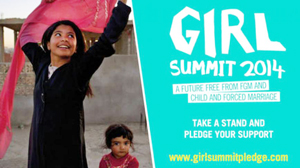
Girl Summit 2014: A silver lining for girl child
Parvez Babul | Tuesday, 22 July 2014

The Girl Summit 2014 is scheduled to begin in London today (July 22). Heads of government including the Prime Minister of Bangladesh, women and human rights activists, community leaders, civil society organisations (CSOs) and development partners will join the summit. The international event is expected to see fruitful discussions on how to end two of the worst human rights violations in the lives of girls: child and forced marriage and female genital mutilation (FGM).
It is estimated that 14 million girls are married before they attain the age of 18 every year across the globe. Especially in developing countries, one in three girls is married off by 18. About 125 million women and girls today are being forced to undergo horror of female genital mutilation. These practices expose women and girls to serious health risks and perpetuate a cycle of poverty for families, communities, as well as all the nations. Though these harmful and inhuman practices are condemned globally, very little has been done to stop these.
The Girl Summit 2014 in London, experts hope, will be an effective and perfect platform to make commitments to make a real change for women and girls. All the global activists now have a unique opportunity to devise ways to prevent and mitigate the harmful effects of both child marriage and female genital mutilation. But this urgently requires political will and financial commitment to execute effective programmes.
The Girl Summit 2014 will be hosted jointly by the government of United Kingdom and the UNICEF. It aims to secure substantial commitments from heads of governments, national and international organisations, key stakeholders, development partners as well as both print and electronic media worldwide. The organisers hope that the summit will bring much-needed financial and technical resources to the efforts as well as pledges from governments and civil society to work together in more strategic ways. It will encourage the girls to work by themselves also to ensure that all of them across the world are safe as they deserve, according to the Human Rights Convention of the United Nations and the Constitution of every state.
Therefore, to achieve the Sustainable Development Goals (SDGs) beyond 2015, let the dreams of girl children come true. Let our girls and women enjoy a healthy, wealthy, empowered and prosperous life as boys and men enjoy. We hope that this Girl Summit will play a very significant role to provide the globe with time-appropriate recommendations with specific guidelines to put an end to both child marriage and female genital mutilation.
Research shows that Bangladesh has the fourth highest rate of child marriage in the world. Sixty-four per cent of girls are married before the age of 18. This is not only a significant violation of the human rights of girls in Bangladesh, but it has also been a key barrier to achieving six of the eight Millennium Development Goals (MDGs). By the end of 2013, over half of the 3.7 million Bangladeshi women between 20 and 24 were married before they were 18.
The Bangladesh National Girl Child Advocacy Forum organised a roundtable titled 'Child Marriage Restraint Act (Draft) - 2013: Present Situation' at the National Press Club, Dhaka recently. The discussants made a call for joining hands of all stakeholders to combat child marriage in Bangladesh and enact the law 'Child Marriage Restraint Act (Draft) 2013' as soon as possible for improvement of lives of girl children in Bangladesh.
The discussants of the roundtable added that child marriage is an immature marriage where young girls are forcefully compelled to have physical relationship, which has a negative impact on their mental and reproductive health. So, birth registration must be ensured for a girl child within 45 days of her birth to combat child marriage. It is not possible to prevent child marriage without ensuring proper safety and security of the girls. Girls, who are the victims of child marriage, give birth to the stunted child and child with 45 per cent less weight. These lean, weak and malnourished children are the cause of hindrance to national development. As a result, they are unable to break the vicious cycle of negligence for girl children, malnutrition, poverty, illiteracy, disabilities, violence against them and other obstacles.
Girls, who are victims of child marriage, deliver children while they are still children and its puts them at risk of death or suffering for the rest of their lives. They are more likely to be poor and stay poor. Forced marriage victims can suffer physical, psychological, emotional, financial and sexual abuse.
Collective approach is essential to reduce child marriage. Local administration, media, representatives of local government, national parliament, NGOs, civil society organisations, women and human rights activists, and law enforcing agencies should work together through coordinated and integrated ways. There are lots of loopholes needed to be removed to combat child marriage. Marriage registrars should be made accountable to stop child marriage. Religious leaders may be involved to launch awareness campaign that child marriage is restricted, illegal and punishable offence. Scouts and Girl Guides of all the educational institutions may also be engaged to campaign against child marriage nationally as part of a social movement.
Girls are assets like boys, if properly educated. They are never a burden. So, let us raise our voice and join social and global movement ending the two scourges they face. Let's give girls a choice, and make available opportunities to them for a bright future. Moreover, together 'WE CAN' definitely think globally and act locally to stop child marriage and female genital mutilation.
The writer is a media person, a member of Bangladesh National Girl Child Advocacy Forum, and an author of books on women's empowerment, climate change, media and contemporary issues. parvezbabul@gmail.com